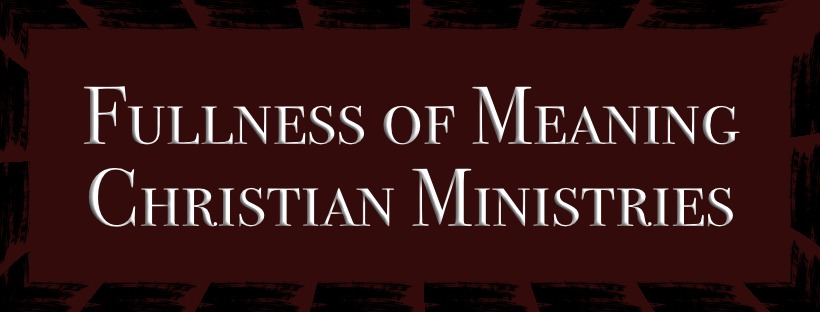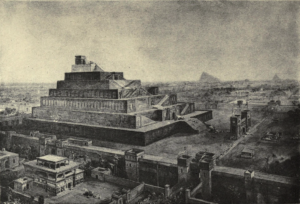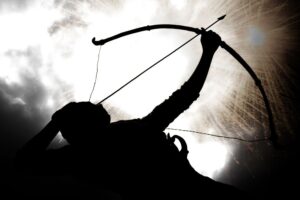DAEG
The “DAY” can mean several things to many people in different cultures. “Daeg” is the term for day in Anglo Saxon. Daeg can refer to the time that the sun brightens the sky. Daeg can also refer to the ‘event’ of some kind of ‘time’ such as a ‘time’ of happiness, ‘time’ of sorrow, in the abstract, the ‘time’ of creation. It can mean someone’s ‘time’ to be alive—i.e., ‘their era’. When they are past, their life or ‘time’ can be a ‘time’ to be celebrated or honored– a memorial.
Such related names can and do go back as far as the Akaddian, “Digir” – “god”, Proto-Indo-European, “Dyaus” – day/sun/god/deity, “Theos”, “Zeus”, “Deus”…etc. all, which can relate to the “SUN” as god, the “Sun-God”, and “GOD” as the sun.
My intimation is that Beowulf is seen *as* the Sun/ god/ King and Grendel is seen *as* the Night, Evil one, Dark one (nith; nicor, NICK {cf. “old Nick”} in this astrological battle.
UHT
This anatomy of DAEG-time connotes the ending of night or “UHT”. Uht requires ‘darkness’ to leave since Uht is the ‘end of night’. Specifically, Uht is the ‘time’ right before daybreak. Nevertheless, darkness -i.e., UHT, – still has its reign during its time.
In the Anglo Saxon text of Beowulf we see the “time” at which the demonized Grendel acted. Grendel is a creature of the night. He attacked Heorot at night, at least once in the uhta, Uht, (or uhte), i.e., the hour of darkness before dawn, this being the deepest part of the night.
1 Grendel’s association with ‘wan’ (“to wane”) may also inform puns. It may be no coincidence that in persecuting Heorot and its inhabitants he wið rihte wan ‘fought against right’ , or that he wan / hwile wið Hroþgar ‘fought for a time against Hroðgar’. In both cases wan is obviously the past tense of winnan ‘to fight’, but may pun on the adjective wan ‘dark’. Also, when held fast by the arm in Beowulf’s grip, Grendel is heard “sar wanigean” – ‘bewailing (his) pain/wound’. Here the verb wani(ge)an (with long root vowel) may pun on wanian ‘to wane, diminish’ (with short root vowel). Of course, ‘the pain/wound diminishing’ is precisely the opposite of what is actually happening in a direct, physical sense, but may also detect a subtle anticipation of Grendel’s dismemberment as an image of the lunar wane, of the moon’s ‘dying’. This suggestion is encouraged by Beowulf’s likely description of how “hyne sar hafað / in niðgripe nearwe befongen” ‘the pain/wound has him [i.e., Grendel] narrowly/darkly/encompassed in a hostile/dark-moon. If there is a hint of Grendel’s ‘waning’ as he loses his arm, his ‘un/bad-sword’, then we may have an implicit parallel to the subsequent loss by ‘waning’ of the blade of the giant sword which serves as an extension of Beowulf’s sword-arm. Were Beowulf to contain more direct lexical references to the moon’s waning or dark phases, the proposed association of Grendel (and, we shall find, his mother and the climactic dragon) with the waning or dark moon would be strengthened. Old Norse has a specific word for the waning or dark moon: nið. This noun is attested both as a simplex and as the first element of compounds, including mythological personal names and toponyms. It may well be related to the Old Norse adverb niðr ‘down’, ‘beneath’ and Thus, early in the poem we hear that after Grendel had attacked Heorot, Ða wæs on uhtan mid
ærdæge / Grendles guðcræft gumum undyrne, a passage that might be translated: ‘Then, at the juncture of the last hour of darkness with dawn Grendel’s battle-strength was unsecret [i.e.,
revealed] to men’ – i.e., Beowulf (a shadowing “messianic” figure) fought and dismembered Grendel ( the demonized “Satan” figure) in the “uhthelm þone ‘the hour-before-dawn uproar/crash’ “.
Grendel was referred to as one of the “scaduhelma gesceapu” or “shapes of shadow-helms”. Grendel is related to the moon waning or “wana” —i.e., “the moon’s want of light”. Such fulfills the UHT idea *as* Grendel.
One of my biggest intrigues is that Grendel and his mother were “Moor-Walkers”…that is: they walked up to and on the border line of the dark swamp but did not cross over into the cultivated area of Herot until Grendel could take no more of Hrothgar’s revelry with feasts of drinking and gormandizing.
Some scholars say that this was a “christianizing” idea of Satan entering into the garden of Eden. I feel that both pagan, Jewish and Christian ideas of ‘horizons’, ‘boundaries’, ‘pagan’, ‘heathen’, ‘cutting off point’, ‘illegal entry’, etc.. could be compatible here in this luscious story of Beowulf.
DAEG-RIMA
Next in our sequence of horizons is the “Dawn” or “Daeg-Rima”. This means the “rim” or “border” of the day. This is the narrow space of time between night and day, when the sun just peeps over the horizon. Daeg-red and daeg-rima are followed by “Aer-Morgen” or “Daybreak”. After “Aer-Morgen” is Morgen or “morning”.
Here is a beautiful Old English text that brings together Easter for me today:
“THE LORD HIMSELF OVERCAME DEATH AND MADE THE DEVIL FLEE. THE PROPHETS OF THE ANCIENT DAYS HAD SAID HE WOULD DO SO. IT ALL HAPPENED AT ‘’UHT’’, BEFORE
‘’’DAEG-RED’’’. A DIN RESOUNDED, LOUD FROM THE HEAVENS, WHEN HE DESTROYED AND DEMOLISHED THE GATES OF HELL”.
As I played percussion this morning for the Sunday Sunrise Service this Easter Morgen outside I was aware of this beautiful idea that many of our ancient mothers and fathers knew this resurrection theme of ascent through the horizons. It was 43 degrees, quite chilly, but an icey-fire shot through my soul arresting
all of my senses as I was halted in awe of God’s SON as HE rose above the horizon in Resurrection for ALL of us.
OE niðer. Since the darkness of night ensues when the sun passes below the horizon, it was perhaps thought that when the moon was apparently absent from the sky on a cloudless night, it too was beneath
the ground.
In the language of Anglo Saxon Theology, great things happen at UHT. Such Great Things include the Greatest happening; Our Christ’s “Harrowing of Hell”. We see this idea in medieval art and literature.
The Harrowing of Hell is the “time” when Christ went into “NIGHT”. 2
From this descension and all of the horizons by which HE passed through to the depths of the Holle or Hell, HE came back through these Horizons to show HIS mastery over times, space, matter, etc. HE, Jesus Christ, is without bridle to the elements which bind us.
2 Here we have the final word, night, that I need to dig into. The word “night” has a very interesting etymology. To go past Anglo Saxon and to return again we might go to the Greek: Nux, nuktos, nyk, nek, etc. Such words were associated with “dark, danger, death… . The Greek nyctalopia, nikto-tropism, nyktophobia, etc. are examples of “NYK ” as ‘NIGHT’ in their meanings.Take for example the Genus of
night flowers in Greek called Nyktanthes or NYKTEA— the genus of the snowy owl of the night hunt. Nyctereutes is the genus of the raccoon dog. Nykteris is the genus of bats. Nykticorax is the genus of the Night Heron.
Continuing this NYTOPIA we now turn to the “privative” or ‘negation’ of the dark acting thing to speak of its “light-bearing-actions”. Hence, in the Greek, “Aktis” means..”Ray of Light” instead keeping its common prefix “N” or “nu” in the Greek alphabet. Otherwise, “Naktis” would be related to “night activity”. The Germanic “night” seems to be used in the sense of ‘the unseen’ or something not in sight — as does the Hebrew, Sheol, “the unseen”, or “Holle” which can mean, “hell” as in ‘a hole in the ground’, ‘a separation’, ‘an unseen place’, ‘darkness’, ‘without light in a dark hole’ The German goddess *Frau-Holle* was a kind and hidden goddess of frost or cold. She is recognized in particular in the winter as the sun is reduced in length at mid winter solstice. Again, to the pagan world…. ‘Where the god’s eye–or sun, or
Heaven’s gate is seeing us less’ . The deadly “nightshade” is euphemistically called “Belladonna” in Italian. Mr. O. Winslow in his “The Inner Life ” written in 1850 figuratively says: “Satan has ever sought to engraft the deadly nightshade of error upon the life-giving ROSE OF SHARON:. Belladonna is Italian for “beautiful lady” –which opens the pupil – also does the deadly drug. In E. Hamilton’s “discussion of Flora” in 1851 she says, “Belladonna was employed by Leucota, a famous poisoner of Italy, to destroy the beautiful women of whom less beautiful but more powerful ladies were jealous” — as to put the beautiful ones ‘out of sight’.





